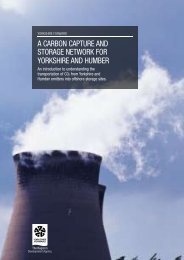Final report for One North East And NEPIC 21/12/10 - The Carbon ...
Final report for One North East And NEPIC 21/12/10 - The Carbon ...
Final report for One North East And NEPIC 21/12/10 - The Carbon ...
You also want an ePaper? Increase the reach of your titles
YUMPU automatically turns print PDFs into web optimized ePapers that Google loves.
<strong>The</strong> case <strong>for</strong> a Tees CCS network<strong>Final</strong> ReportAny organisation should share lessons with others on stakeholder organisation 99 , riskmanagement and allocation, attracting investment, technical specification <strong>10</strong>0 , and CCScosts and per<strong>for</strong>mance.Recommendation Three – Provide key stakeholders with an independent, robustassessment of accessible CO 2 storage options.Recognising that transport and storage costs and risks will depend on the storage sitechosen, and that transparency will be critical to obtaining the necessary stakeholdersupport, this <strong>report</strong> recommends a continuation of ef<strong>for</strong>ts already underway to evaluateaccessible CO 2 storage options.Recommendation Four – Strengthen and support the commercial scale <strong>for</strong> a CCSanchor project and a CCS network in <strong>North</strong> <strong>East</strong> England.Local stakeholders should critically review, strengthen and where appropriate, stronglypromote proposals <strong>for</strong> CCS demonstration projects to be located in the <strong>North</strong> <strong>East</strong> ofEngland and the overall business case <strong>for</strong> a CCS network. This will ensure suitablenetwork anchor projects are seen as viable in delivering all the objectives of CCSdemonstration and have the support of stakeholders making them realistic candidates tonucleate a CCS network.Recommendation Five – Include CCS within planning policies.Continue to examine opportunities to reduce costs and barriers through the optimalinclusion of CCS infrastructure requirements within national and local planning policies.This could include updating further the <strong>North</strong> South Tees Industrial DevelopmentFramework to safeguard further potential rights of way identified <strong>for</strong> potential CO 2pipelines.Recommendation Six –Explore public/NGO support <strong>for</strong> CCS deployment in the TeesValley.Consider a pilot public/NGO engagement study to understand social drivers and barriers<strong>for</strong> CCS deployment in Teesside.Recommendation Seven – Continue to support other options <strong>for</strong> CO 2 reduction.Recognising that reducing the amount of CO 2 to collect will reduce absolute costs <strong>for</strong>capture, transport and storage, Tees Valley CO 2 emitters will still need to continue toexamine all opportunities <strong>for</strong> reducing CO 2 emissions and share their <strong>for</strong>ecast emissionswhere possible.Recommendation Eight – Examine the impacts of pipeline entry specifications onthe costs and feasibility of CO 2 capture and compression <strong>for</strong> <strong>North</strong> <strong>East</strong> emittersand potential storage operations.Recognising that the entry specification <strong>for</strong> any transport network may influence captureand storage investments, the Task Force should ensure key stakeholders are fullyin<strong>for</strong>med as to the impacts of choices, to ensure system-wide benefits are not threatened.99 See <strong>for</strong> example Yorkshire Forward‟s CCS network, Scotland, Rotterdam and the ZEP Task Force.<strong>10</strong>0 As an example, DNV‟s Pipetrans phase project examines common entry specification <strong>for</strong> CO 2 pipelines.68







